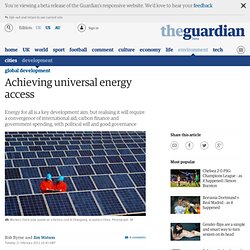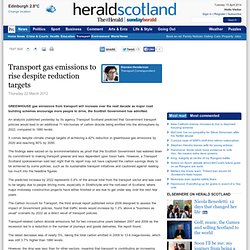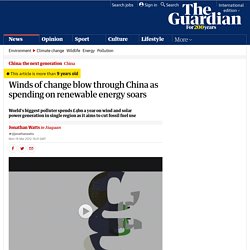

Achieving universal energy access. For decades, achieving universal energy access has been a key development goal.

Once solved, the resolution of many other development challenges might follow: lighting, cooking, heating, cooling, mobility and communications. But the International Energy Agency's World Energy Outlook for 2011 estimates that 1.3 billion people across the world do not yet have access to electricity and 2.7 billion rely on traditional biomass for their energy needs.
If we continue as we are, according to a recent report from development NGO Practical Action, 900 million people will not have access to electricity in 2030 and 3 billion will still be cooking with traditional fuels. Transport gas emissions to rise despite reduction targets. Custom byline text: DAMIEN HENDERSON Transport Correspondent An analysis published yesterday by its agency Transport Scotland predicted that Government transport policies would lead to an additional 71 kilo-tonnes of carbon dioxide being emitted into the atmosphere by 2022, compared to 1990 levels.

It comes despite climate change targets of achieving a 42% reduction in greenhouse gas emissions by 2020 and reaching 80% by 2050. 237na1. Cost of green jet fuel could match kerosene by 2018. The cost of some aviation biofuels produced from non-food vegetable oils could reach parity with conventional fuels by 2018 if production efficiencies continue to improve, analysts have said.

EU to vote on oil sands pollution. 21 February 2012Last updated at 08:27 By Pallab Ghosh Science correspondent, BBC News The Canadian province of Alberta has vast oil sand reserves European Union officials are expected to vote on draft legislation that would label Canadian fuel as more polluting than oil from other parts of the world.

Winds of change blow through China as spending on renewable energy soars. The remote, wind-blasted desert of northwestern Gansu could be the most unloved, environmentally abused corner of China.

It is home to the country's first oilfield and several of the coalmines and steel factories that have contributed to China's notoriety as the planet's biggest polluter and carbon dioxide emitter. But in the past few years, the landscape has started to undergo a transformation as Gansu has moved to the frontline of government efforts to reinvent China's economy with a massive investment in renewable energy. The change is evident soon after driving across the plains from Jiuquan, an ancient garrison town on the Silk Road that is now a base for more than 50 energy companies. Wind turbines, which were almost unknown five years ago, stretch into the distance, competing only with far mountains and new pylons for space on the horizon. Lake Kivu gas: Turning an explosion risk into a power source. More than 1,000 people died in 1986 when a lake in Cameroon released a cloud of CO2 that suffocated entire villages.

A much larger lake in Rwanda - with two million people living nearby - is also at risk of eruption, but plans are afoot to make it safer. In the early evening on Lake Kivu, along Rwanda's border with the Democratic Republic of Congo, lights bob on the surface of the water. They're fishermen's lanterns hanging off wooden boats to attract herring. Lake Kivu's fish are a crucial source of food for the two million people who live around the perimeter. Electric cars need a clean energy source, study suggests. Could it be that electric cars cause more overall pollution and are more harmful to health than conventional gasoline powered cars?

In China, where electricity is generated primarily through the burning of fossil fuels, the answer appears to be yes. A research team from the University of Tennessee, Knoxville, has found in China the potential for a more negative overall impact – on pollution and health – from electric cars than from gasoline cars. Study authors say their results point to electric vehicles being attractive if they are powered by a clean energy source. They also found that electric bikes had the lowest environmental impact in China. Storm caused wind turbine fire. BAE provides details of 'structural battery' technology. 13 February 2012Last updated at 13:55 ET The Lola-Drayson electric car is an opportunity to test the structural batteries which will power some on-board systems.

In this image a battery is indicated with yellow arrows Torches, drones and an electric Le Mans racing car are all test-beds for a new kind of "structural battery", BAE Systems has said. The batteries use carbon fibre and can form part of the body of a device. How Oil Prices Affect The Price Of Food (USO, MOO, DBA, DBC, XLE) The current global food system is highly fuel- and transport-dependent.

Fuels will almost certainly become less affordable in the near and medium term, making the current, highly fuel-dependent agricultural production system less secure and food less affordable. It is therefore necessary to promote food self-sufficiency and reduce the need for fuel inputs to the food system at all levels. The connection between food and is systemic, and the prices of both food and fuel have risen and fallen more or less in tandem in recent years (figure 1).
Modern agriculture uses oil products to fuel farm machinery, to transport other inputs to the farm, and to transport farm output to the ultimate consumer. Oil is often also used as input in agricultural chemicals. Bulgaria becomes second state to impose ban on shale-gas exploration. Pennsylvania Senate Passes Bill on Marcellus Shale Gas Drilling. Vorbeck Materials Earns Innovator Award for Graphene-Based Energy Solution. By Cameron Chai Vorbeck Materials will participate in the Arpa-E summit to be conducted on February 27, 2012 in Washington, DC.

The company, in collaboration with Princeton University and the Pacific Northwest National Labs (PNNL), is working on the commercialization of next-generation lithium batteries using its graphene technology. This novel development paves the way to enhance battery performance, facilitate rapid charging and develop high-power batteries for consumer electronics and transportation. High performance batteries engineered by PNNL utilizing Vor-x, the patented graphene technology of Vorbeck Materials, have generated unprecedented energy storage capacities.
Batteries integrating graphene technology have demonstrated dramatic increase in recharge rates when compared to existing rechargeable batteries. Price of Solar Energy Decreasing in India. Solar energy may have a reputation to be more expensive in most parts of the world, but not in India. In the world's second most populous nation, electricity stemming from solar energy is now cheaper than oil-based energy. The Indian government also has an objective to inaugurate 20,000 megawatts of solar panels by 2022. India's solar success may have positive implications for other developing countries to show a new and inexpensive alternative energy source for use in not only for basic heating, but to also use for new and innovative technology. According to the Bloomberg New Energy Finance (BNEF), prices of solar panels fell 50 percent in 2011, and are now one quarter of the price they were in 2008.
The BNEF says that solar electricity now costs 8.78 rupees ($0.18) per kilowatt-hour, compared to 17 rupees ($0.34) per kilowatt-hour for oil-based electricity. Solar energy also has gotten more support—in terms of monetary investment—over the past year. Nano Letters - Available Supporting Information for This Article Terms & Conditions Electronic Supporting Information files are available without a subscription to ACS Web Editions.
The American Chemical Society holds a copyright ownership interest in any copyrightable Supporting Information. News. Energy Security For Whom? For What? "Energy security" is full of pitfalls, both as policy and as rhetoric. Other ways are urgently needed of discussing and organising for a democractic, fossil-free future. How can fossil fuels and uranium be kept in the ground and agrofuels off the land in ways that do not inflict suffering upon millions? Mainstream policy responses to these issues are largely framed in terms of "energy security". Windfarms that float – or fly – could be the future of energy generation. Hywind floating windmill being towed to its trial site in deep water off Norway.
Photograph: Oyvind Hagen Six miles off south-west Norway, the first full-scale demonstration of a floating wind turbine heaves and sways in the North Sea. The depth of water, at 200 metres, rules out driving piles into the seabed, or mounting the turbine on a submersible tower. Local opposition to onshore windfarms has tripled, poll shows. The Dark Side of the QE Circus - Commodity Trade Mantra. A home heating system with a brain. Five technologies to watch. 276na3. Chemicals and biofuel from wood biomass. US military combines green and mean to fly drones on biofuels. UK wants renewable energy target scrapped. UK's renewable energy sector has already suffered a series of blows with Tory MPs attacking subsidies, including those for wind farms. Use nuclear waste to power UK, says top scientist. Donald Trump 'must not blow Scotland's renewables targets off course' 29 February 2012Last updated at 01:22.
Oil supply’s ‘tipping point’ long gone? U. WASHINGTON (US) — Stop wrangling over global warming and instead reduce fossil-fuel use for the sake of the global economy. That’s the message of a commentary in the journal Nature in which scientists say the economic pain of a flattening oil supply will trump the environment as a reason to curb the use of fossil fuels. “Given our fossil-fuel dependent economies, this is more urgent and has a shorter time frame than global climate change,” says James W.